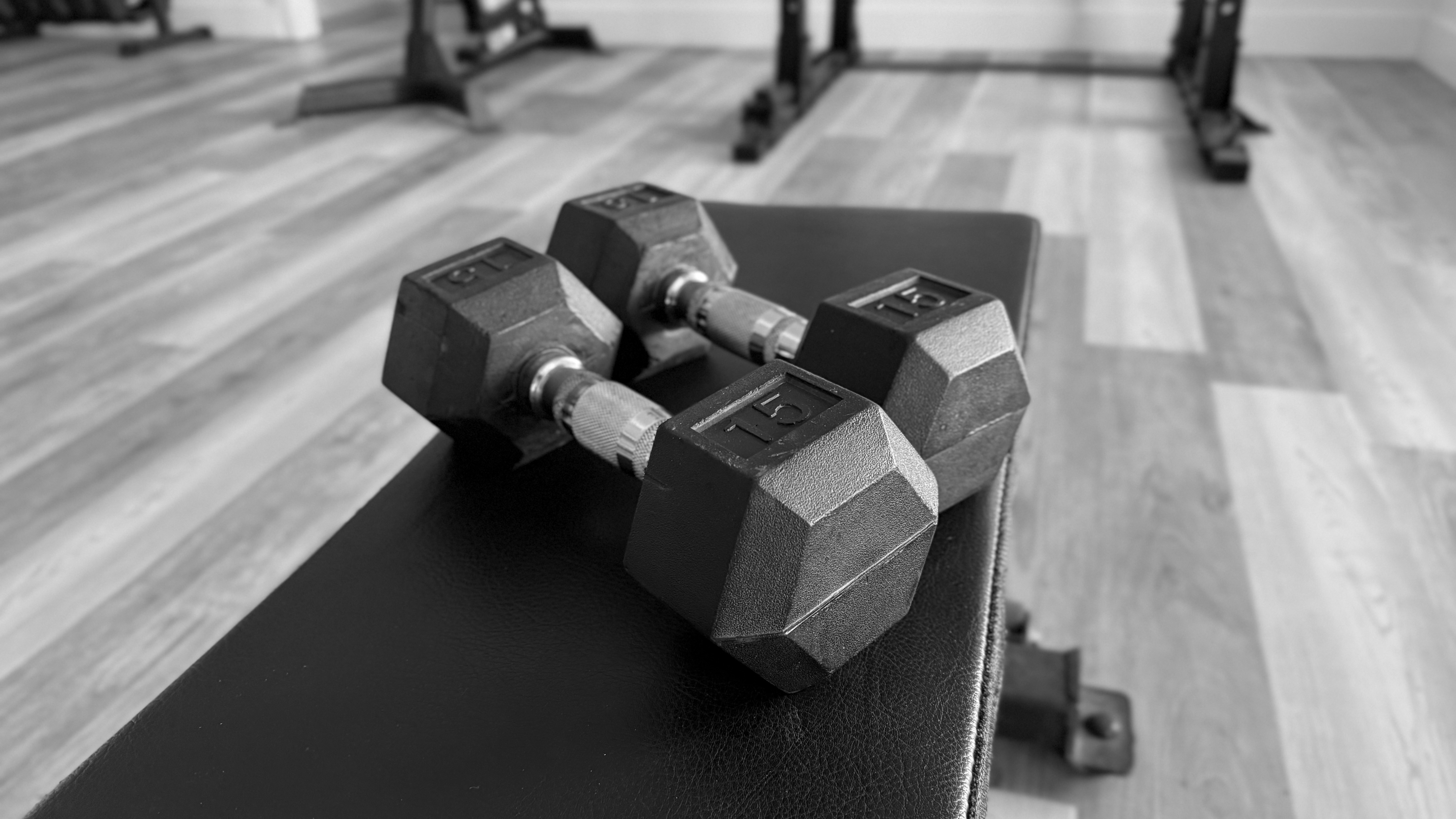20 Minute Strength Training
Read this Article on My Website
In my office, lack of time is one of the most quoted reasons for not working out. This can certainly be true for many people. Work, kids, illnesses, and other life circumstances can challenge one's health. I have often worked out after work at 6-7 p.m. This is how I found out it helps me sleep better.
So what is the minimal amount of time to strength train?

First, let's cover a few ground rules before discussing the program.
How You Should Train
All training programs should be approached as an individualized endeavor. You should do what you like and focus on the available equipment (bands, dumbbells, barbells, etc.) and, more importantly, personal goals. However, there are, in general, a few rules you should follow when starting.
- Major compounding lifts like bench presses, deadlifts, and squats are essential and more beneficial than isolated muscle training.
- Rest at least 1:30 to 2:00 minutes between sets.
- Take one rest day between each exercise day.
- Start low and go slow—men with 15 lbs and women with 10 lbs.
- Increase by 5 lb each month, especially if you are a novice or elderly.
- Per the American College of Sports Medicine, train at least 6-12 repetitions per exercise.
- Abs are not built in the gym but in the kitchen.
- For safety reasons, the first exercise should be the most complex one.
- You can warm up with a few lighter-weight repetitions and/or body-weight-only sets.
- Ensure you drink plenty of water before, during, and after training.
Now that the ground rules are done, let's go over the program itself.
20 Minutes 3 times a Week
Here is the absolute basic resistance training workout.
With dumbbells, do the following.
Rest 2:00 between each set.
Warm up with a lower weight and fewer reps before the first exercise.
Day 1 - Push Day
Chest Presses - 3 sets with 10 reps each.
Overhead Presses - 3 sets with 8 reps each
Overhead Tricep Presses - 3 sets with 10 reps
Day 2 - Pull Day
Deadlift - 3 sets with 10 reps
Bentover Rows (can be on the bench) - 3 sets with 10 reps
Lat Pulldowns (machine or bands) - 3 sets with 10 reps
Day 3 - Legs Day
Goblet Squat - 3 sets with 10 reps
Calf Raises - 3 sets with 10 reps
Lunges - 3 sets with 10 reps
TIP: To not have to think at all, just do a set every 3 minutes. So if you start at 2:00 pm then your next set will be at 2:03 pm and so forth. This gives you 1:00 minute to do the exercise and 2:00 minutes of rest. I use the Seconds App to setup 3 minute intevals.

The total time for each day would be 3:00 (minutes /set) x 3 (sets/exercise) x 3 (exercises) = 27:00 minutes plus 3 minutes for the warm-up, so about 30 minutes total. This is the bare minimum. Resistance training will give you far better benefits than just training cardio alone.
Supersets
A superset is when you combine two exercises back to back without a rest period between them. For instance, you can combine an upper-body push movement with its antagonistic pull movement. You can do the push-up set for 10 reps, then the bent-over row for 10 reps, then rest for 2:00 minutes. This shaves off 2:00 minutes from the workout. Taking this further, you could combine the push and pull day from above. A few small studies have shown similar outcomes in hypertrophy and strength when comparing traditional versus superset workouts.
Push-Pull Superset (combined) Day
Chest Press + Bent Over Row
Overhead Press + Lat Pull Downs
Deadlift + Tricep Extensions
Let's Break down the First superset.
Chest Press 10 reps, then right into Bent Over Rows for 10 reps. Rest for 2:00 minutes, then repeat 3 times.

With Supersets you can completely eliminate an entire day.
However, when you first start weightlifting, I do not recommend supersets because they may be mentally stressful and affect your form. In other words, the stress on your nervous system increases, which can lead to a breakdown. I would do 8 weeks of individual exercises on separate days and then transition to supersets if needed.
Cardiovascular Training
The American Heart Association and other health organizations recommend at least 150 minutes of moderate-intensity weekly exercise for adults to maintain cardiovascular health and reduce mortality risk. We've already spent 60 minutes on strength training, so we have 90 minutes remaining. You can do cardio training after your strength training or on a separate day. Please do not do it before your strength training because it can compromise your form and lead to injury. I would break up the cardio into 30-minute intervals that you can perform consistently over time.
Examples include:
- Walking outside for 30 minutes on alternating days.
- Treadmill for 30 minutes at various incline levels and speeds.
- Swimming at your local fitness gym or neighborhood pool.
- Recumbent Biking (great if you have knee pain)
- A Stairmaster
Both moderate and vigorous walking exercises, performed once or thrice weekly, have been shown to improve cognitive performance and reduce depression severity in older adults, even in those with prior cognitive performance decline. I wouldn't do exercises like rowing or using a ski erg because sustaining them for 30 minutes may be difficult.
Program Review

IMPORTANT: Day 7 should be a complete rest day.
Weightlifting Benefits
Weightlifting has multiple health benefits, including lowering blood pressure and preventing dementia, reversing insulin resistance, osteoporosis, falls, and sarcopenia (loss of muscle as we age). One thing that most people don't know is that it also helps to tighten up our skin and makes us look younger. Resistance training in older adults also increases power, reduces difficulty performing daily tasks, enhances energy expenditure and body composition, and promotes participation in spontaneous physical activity. This means you can do something fun when you think of doing something fun!
If you find this article helpful, please share it with someone who might need it. I aim to make the world healthier, one day at a time.
Disclaimer: This newsletter is for general informational purposes only and does not constitute the practice of medicine, nursing, or other professional health care services, including the giving of medical advice, and no doctor/patient relationship is formed. The use of information in this newsletter or materials linked from this newsletter is at the user’s own risk. The content of this newsletter is not intended to be a substitute for professional medical advice, diagnosis, or treatment. Users should not disregard or delay in obtaining medical advice for any medical condition they may have and should seek the assistance of their healthcare professionals for any such conditions.
References
- Int. J. Environ. Res. Public Health 2022, 19(2), 874; https://doi.org/10.3390/ijerph19020874
- Iversen, V.M., Norum, M., Schoenfeld, B.J. et al. No Time to Lift? Designing Time-Efficient Training Programs for Strength and Hypertrophy: A Narrative Review. Sports Med 51, 2079–2095 (2021). https://doi.org/10.1007/s40279-021-01490-1
- Robbins DW, Young WB, Behm DG, Payne WR. Effects of agonist-antagonist complex resistance training on upper body strength and power development. J Sports Sci. 2009;27(14):1617–1625. doi: 10.1080/02640410903365677
- García-Orea, G., Rodríguez-Rosell, D., Ballester-Sánchez, Á., Da Silva-Grigoletto, M., & Belando-Pedreño, N. (2023). Upper-lower body super-sets vs. traditional sets for inducing chronic athletic performance improvements. PeerJ, 11. https://doi.org/10.7717/peerj.14636.
- u, D., Yu, A., Bernal, J., Fong, D., Chan, D., Cheng, C., & Siu, P. (2022). Effects of exercise intensity and frequency on improving cognitive performance in middle-aged and older adults with mild cognitive impairment: A pilot randomized controlled trial on the minimum physical activity recommendation from WHO. Frontiers in Physiology, 13. https://doi.org/10.3389/fphys.2022.1021428.



